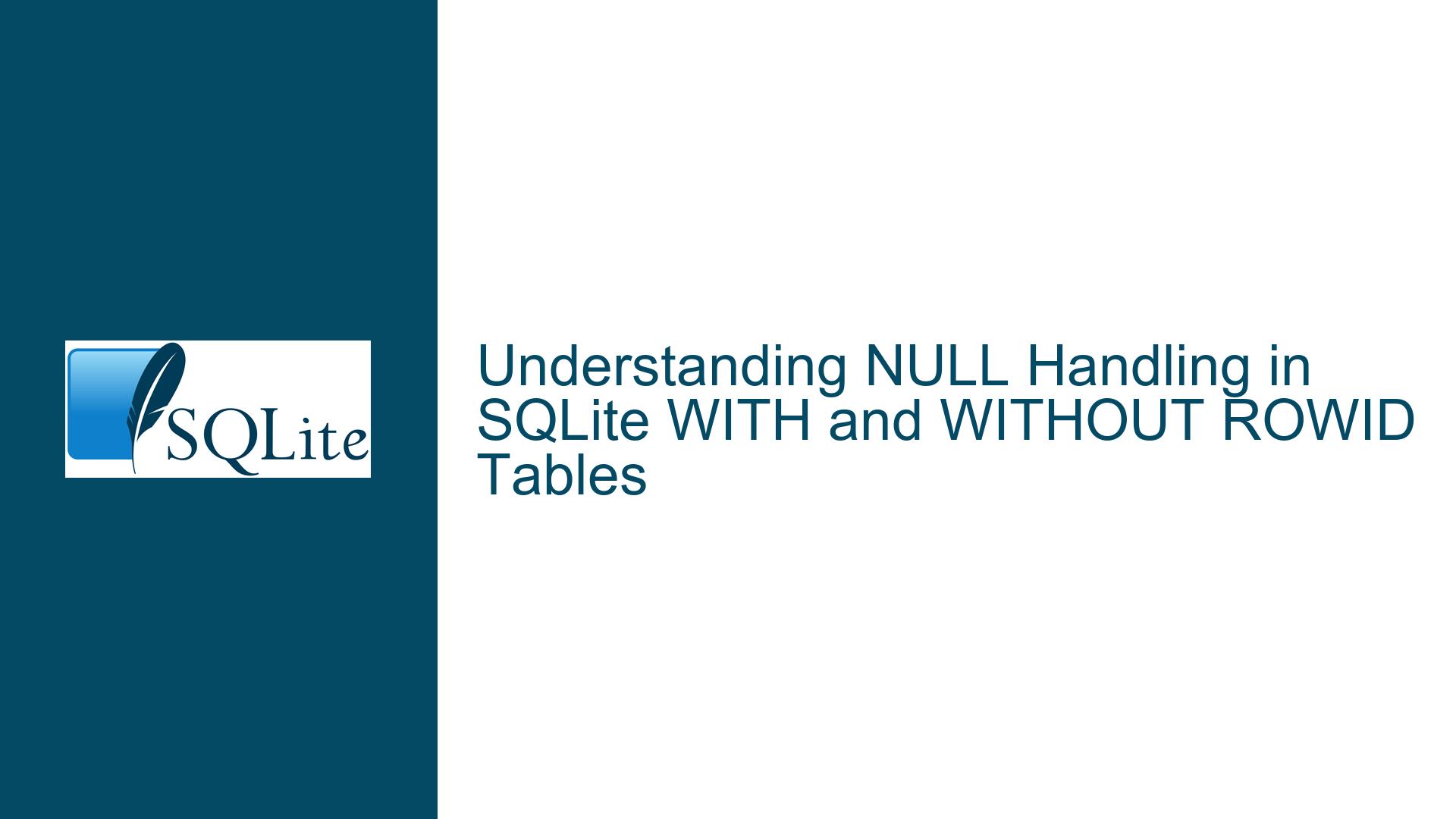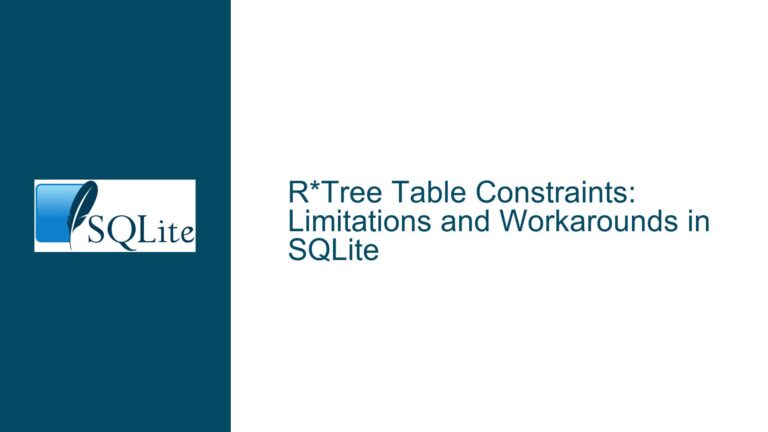NULL Handling in SQLite WITH and WITHOUT ROWID Tables
SQLite WITHOUT ROWID Tables Enforce NOT NULL on Primary Keys
In SQLite, the behavior of NULL values in primary key columns differs significantly between standard rowid tables and WITHOUT ROWID tables. This distinction is crucial for database designers and developers to understand, as it can lead to unexpected errors and data integrity issues if not properly accounted for. The core issue revolves around the enforcement of the NOT NULL constraint on primary key columns in WITHOUT ROWID tables, which is not enforced in the same way in standard rowid tables.
When you create a standard rowid table in SQLite, the primary key columns are not automatically enforced with a NOT NULL constraint. This means that you can insert NULL values into these columns without triggering an error. However, when you create a WITHOUT ROWID table, SQLite enforces a NOT NULL constraint on all primary key columns, in accordance with the SQL standard. This enforcement is strict and will result in an error if you attempt to insert a NULL value into any primary key column.
The difference in behavior stems from the underlying implementation of these two types of tables. In a standard rowid table, the primary key is essentially a unique index on the rowid, which is an internal integer identifier that SQLite uses to uniquely identify each row. The primary key columns in such tables are treated as if they were part of a UNIQUE constraint, but they do not inherently enforce NOT NULL. This behavior is a historical artifact of SQLite’s early development and is maintained for backward compatibility.
In contrast, a WITHOUT ROWID table does not have a rowid. Instead, the primary key columns themselves are used to uniquely identify each row. This means that the primary key must be both unique and non-null for every row in the table. The enforcement of NOT NULL on primary key columns in WITHOUT ROWID tables is in line with the SQL standard, which requires that all columns of a primary key be non-null.
Interrupted Write Operations Leading to Index Corruption
The enforcement of NOT NULL on primary key columns in WITHOUT ROWID tables can lead to issues if not properly understood. One common scenario where this can cause problems is during interrupted write operations. If a write operation is interrupted, such as by a power failure or a crash, the database may be left in an inconsistent state. In a WITHOUT ROWID table, this inconsistency can manifest as an attempt to insert a NULL value into a primary key column, which will result in an error.
The reason for this is that WITHOUT ROWID tables rely on the primary key to uniquely identify each row. If a NULL value were allowed in a primary key column, it would be impossible to uniquely identify the row, leading to potential data corruption. This is why SQLite enforces the NOT NULL constraint on primary key columns in WITHOUT ROWID tables.
In standard rowid tables, the rowid serves as the unique identifier for each row, so the primary key columns are not as critical for maintaining data integrity. This is why SQLite allows NULL values in primary key columns in standard rowid tables, even though it is not in line with the SQL standard.
Implementing PRAGMA journal_mode and Database Backup
To mitigate the risks associated with interrupted write operations and to ensure data integrity in WITHOUT ROWID tables, it is important to implement proper database management practices. One such practice is to use the PRAGMA journal_mode command to enable the Write-Ahead Logging (WAL) mode. WAL mode can help to reduce the risk of database corruption by ensuring that changes are written to a separate log file before they are applied to the main database file. This allows the database to recover more gracefully from interruptions.
Another important practice is to regularly back up the database. Regular backups can help to ensure that you have a recent copy of the database in case of corruption or other issues. SQLite provides several tools for backing up databases, including the .backup command in the SQLite command-line interface and the sqlite3_backup API for programmatic backups.
In addition to these practices, it is also important to carefully design your database schema to account for the differences between standard rowid tables and WITHOUT ROWID tables. When designing a WITHOUT ROWID table, you should ensure that all primary key columns are explicitly declared as NOT NULL, even though SQLite will enforce this constraint for you. This can help to make your schema more self-documenting and reduce the risk of errors.
When migrating data from a standard rowid table to a WITHOUT ROWID table, you should also be careful to ensure that no NULL values are present in the primary key columns. This may require cleaning up the data before performing the migration. You can use SQL queries to identify and remove or correct any rows with NULL values in the primary key columns.
In conclusion, the handling of NULL values in primary key columns is a critical aspect of database design in SQLite, particularly when using WITHOUT ROWID tables. By understanding the differences between standard rowid tables and WITHOUT ROWID tables, and by implementing proper database management practices, you can ensure that your database remains consistent and reliable.






